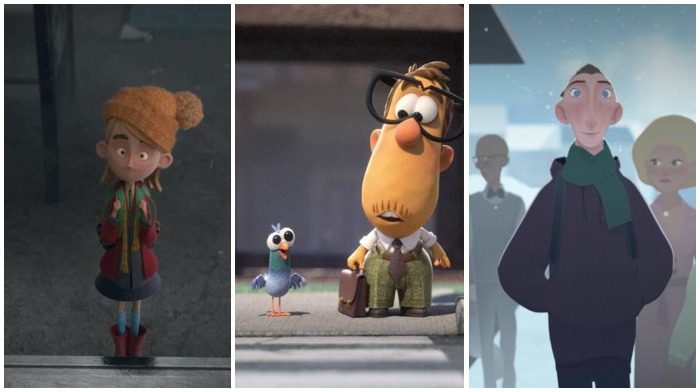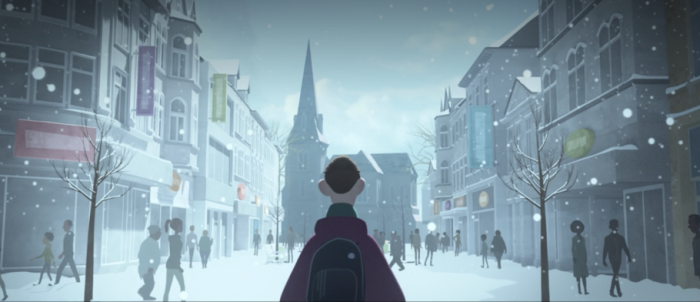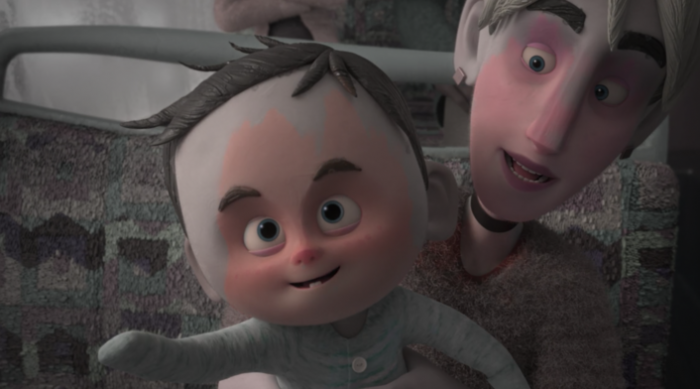
Disney+ just dropped a new season of Short Circuit, a short film series that lets animators step into the director’s chair and experiment with new ideas. The newest season features five shorts from staff members who’ve been with the studio for years, working behind the scenes on some of their most beloved titles like Frozen, Moana, and even the upcoming Encanto.
This new crop of shorts includes Jacob Frey‘s bittersweet trek Going Home, which captures the complex emotions that come from seeing your hometown transform around you. Also featured is Liza Rhia‘s No. 2 to Kettering, a colorful story about a girl trying to liven up her commute, and Ryan Green‘s Crosswalk, which centers on a man building up the courage to step forward, without permission.
Over Zoom, I had the chance to chat with these filmmakers about the inspiration behind their shorts and the exciting process of creating them through the Short Circuit program.
I would love to hear about the inspiration behind each of your shorts and how you got from that initial idea to the story you decided on?
Rhia: I used to get a public bus to school when I was a child and I was surrounded by strangers, adults, and children alike. It used to be the sort of a general consensus to not make eye contact — keep within your bubble. Then, one day, someone just got on the bus and walked upstairs and they smiled at me on the way. My reaction was like, “Oh no, I made eye contact”. Then I realized that actually made me feel really good. I was, I don’t know, 12 or something? So then I took it upon myself to want to smile at other people and I saw the effects of that. When I smiled at someone, they smiled back, and then they smiled at someone else. I got the nickname “the smiler” from all the bus drivers. I wanted to depict that in a film, and that’s really the inspiration for my short.
Frey: The inspiration from my short comes from my personal experience of going home to visit my parents. I think, ultimately, it doesn’t really matter if it’s 20 kilometers or 100 kilometers or thousands of kilometers in my case. But for me, it was really sad to just go home and then slowly start to see things change in the environment. I don’t know. You start to be conflicted about whether this is the home that I’m traveling to. Then being there all of the sudden, it’s like, “Okay…well, I kinda want to go home now.” But also, ultimately, that fear of my parents aging and not being there for me at some point. Then that being the ultimate end of me traveling home really was one of my biggest fears and that’s what inspired my short.
Green: For me, around the time that this opportunity came up, I was thinking a lot about personal freedom versus social living and how those two ideas contrast and work against each other. I was just pondering that while standing at the light right outside Disney Animation. I was just thinking like, “Oh, this is actually a fairly good metaphor for this.” Here’s a socially accepted light that we’ve created for our own safety, but I can see the whole way down the street in both directions: there’s no cars coming yet. I’m still just not allowing myself to move forward. So I just decided to turn this into the short.
I love that they all come from these really personal journeys and specific relationships you have. Did that personal element change at all when the idea left your head and became a collaborative project?
Rhia: Actually, when I was working with my team, a lot of them shared a lot of similar experiences with me. I totally get that working on a film, you can get too close to it and start to lose the perspective. So my producer, Jen Newfield always reminded me to go back to my pitch and remind myself of where I was coming from with this idea to not veer off too far. I was really lucky that I had a great producer to help me to come back to reality.
Frey: Yeah, it’s definitely an interesting process when you start working on it and you have this vision in mind, but then it’s so many people that are joining your team now and, ultimately, help you and come up with new ideas. And something that you thought you had a great vision of is now being inspired with more people joining the team. All of a sudden, it’s becoming this even greater thing than you envisioned it to be. I think that’s a really cool thing about working with all these artists because you just work with some of the best artists in the world and just seeing the results…How you see a shot that wasn’t really that interesting really, but then when it was animated, is just like, “Oh, wow. This is such a cool detail that she added.”
Green: Conceptually, I stayed pretty true to what the initial idea was, but stylistically, even going into it, I didn’t know exactly what style it was. I knew it would be some kind of 3D style, possibly with some 2D in certain sections that people will see when they watch it. But yeah, talking with the team was great because I started talking about things like… This feels like an editorial cartoon to me as some social commentary. I used the word miniature and that triggered us to start talking about, well, stop motion is shot in miniature with tiny sets. So we evolved the look to actually mimic a stop motion set and everything we did was based on that aesthetic.

Jumping off of that, were your ideas for the character designs changed by the collaboration, or did you have those in mind initially?
Green: Character design definitely was…I had some doodles that I had done. We had some of the artists at Disney take some passes on them. In the end, it was a little bit of a mishmash still based on some of my original doodles and some details from other things. Then our modeler, [Sergi Caballer Garcia], created, just based on just a few drawings, a really great model. He has such great design sense that he was able to take those few drawings and create something in 3D for us.
Rhia: Yeah. Similarly, for me, I wanted to go for kind of inspired by stop motion, but just very tactile, oversized texture, something that felt like you could just reach in and touch it like her hat. I just want it to be like, “Ooh, fluffy.” For the character designs, we want it to go for clam-shell eyes to give the illusion of stop motion. That was a challenge in and of itself because a lot of the characters at Disney don’t have that. We don’t have those eyes and we don’t have the rigging for those. So we had to, from scratch, for my main character at least, create a whole new set up for her. That was a really fun journey.
Frey: The design of my character, I think, was inspired by myself, I guess, just because it is a story about me traveling home. It’s really just me traveling back and just going through the city. Because it’s literally, based on my hometown as well. For a lot of those buildings, I took reference from photos in my hometown. But it was really challenging also because we had so many season changes, so we needed to create an extra outfit, sweater, jackets, T-shirts, and different colors. There were a lot of technical challenges in the short film that were a little bit of a concern at the beginning, whether we could finish in time. Which is why we actually changed our style from something that I really wanted to look very realistic to something more painterly with simpler textures in order to be able to cut corners a little bit, to then finish in time and make up for the other technical elements.
For each of you, what are some of the past films you’ve worked on and how do you feel like they informed these shorts?
Rhia: At Disney, I’ve worked on Ralph Breaks the Internet, Frozen 2, Raya and the Last Dragon, Encanto, and…I’m being very careful not to say anything that’s not been announced yet, so those are the ones I’ve worked on.
For me, as an environment modeler, every film I work on, I learn something new. I’m constantly learning in my field. I believe that might be true for a lot of different fields and departments in our studio. So working on my bus… I modeled the whole street and the bus and it was really good because I have this experience of knowing we’re going to need to turn this whole side of the bus off so that we can put the camera there and we can get this angle. Knowing how to work within the model helped me figure out how to make storyboards. It just really helped inform me a lot.
Green: I’ve worked on… I was fortunate to, I guess, to touch every movie since Zootopia so far. So it’s Zootopia and Moana… I worked mostly on Moana, Frozen 2, and Encanto, which is about to come out. For me, I wanted to basically, have the opportunity to work with those same artists that made those movies, but see if they could do something a little different. It was great to push character design in a slightly different way, even the textures and even the scale of what it was so much smaller. If you put our character next on Elsa, he probably goes up to halfway up the calf muscle. It was just great to try something a little different with those same artists.
Frey: I actually joined on Zootopia as an animation trainee. From then on, worked on Moana, Wreck-It Ralph 2, Frozen 2, Raya and the Last Dragon, and Encanto right now. I worked on a few Short Circuit projects… I’ve done some work for Legacy, which is the stuff for the theme parks. I think it really helped me to understand the work of the animators rolling up to the film and just being able to bet how long some will take for them. But then also through the work that I’ve done before my time at Disney, where I had to actually take care of the little steps in production. It helped me actually to be a little bit aware of what type of issues might arise by and actually help the artist how to do the work that might not be super exciting, but will set them up for success to really just have a smoother transition during the production.

How was it different this time around, as the director of the project? What do you feel your big takeaways were?
Rhia: Oh, gosh. For me, it was super different. I’m usually just in my modeling department, in my little bubble, figuring out the tools and pipeline that I know, using my hands a lot, I realize. Just figuring out and communicating with other departments and learning about what they handle and how they handle it was something that I haven’t done before. So I had to really learn to trust other departments and listen to what they know. That was just amazing because whenever we’d have dailies, which is where they show us the work every few days that they’d done, it just blew me away with everything they were doing that I was like, “Okay, I don’t have to have any fears. These guys are amazing.” So yeah, it was awesome.
Green: Going into it, I thought I had to have all the answers. It was just great to talk with all those departments as Liza is saying, with the experts in each of their crafts. I realized along the way that the director’s job really is just to guide the conversation, not to dictate the conversation. You can actually suppress your artists if you don’t give them the chance to offer something that’s in their heads. Going through the process as a director, you have to keep in mind the clarity of your theme and the consistency of style and let the artists flourish along the way.
Frey: It was definitely daunting at first when you’re selected. I’ve tried to apply multiple times in the program and my ideas didn’t make it in. But when you finally started, you’re, of course, super excited, but then it’s also very daunting because I was like, “Wow, I really got to deliver and show what I can do, and really use my time carefully.” I think that was just so cool to just have that luxury of having all these artists contribute on your shorts. I wasn’t really used to [that] before. Like Ryan said, really getting the artists that chance to really add to the shorts because it just makes it so much better. Stuff that you might not have thought about, is already, all of a sudden, there and makes you inspired by new ideas they just add to the film. Ultimately, it’s still the film that you thought you wanted to make, but it’s just become so much better than you envisioned it to be.
Now that they’re completed, what part of these films or the experience are you most proud of?
Rhia: Getting out of my head. Like Jacob, going back to the previous thing, the idea that when you’re selected, you are now going to have to do this. I remember at the beginning just feeling like, I don’t think I’m going to be able to do this. Now, looking at the final products and sitting there with the whole team watching it is just a proud moment. Everyone put so much work into it, and we’re just excited to share it with the world.
Green: Just seeing the final style really speaks to me as far as how much of a team effort this was. I think that’s the part that I really take away from this. That, again, as I mentioned before, not knowing exactly how I was going to do it. I can see everybody’s voice in the final look as the shots go by. I know like, “Oh, this texture is from this person. This movement in the animation is from this person.” It’s a very personal feeling for me watching it.
Frey: I am super proud of the result that we managed to achieve. I’m super thankful for the experience of this project because it was a very emotional topic to make a short about. Then also, lots of people who contributed to that film actually came to me and I had conversations with them about the experience of going home, about their experience losing their parents, and just having those emotional connections with people was very rewarding and cool to have that bond. But then also, I’m really proud of what they experienced working on the short was just fun, that everybody was involved and we were like this little family making this film. I think that’s something that I’m even more proud of than the actual result of the film.
Going Home, Crosswalk, and No. 2 to Kettering are part of Short Circuit season 2, now streaming on Disney+
The post ‘Short Circuit’ Animators Liza Rhia, Jacob Frey and Ryan Green on Making the Leap to Directing Shorts for Disney+ [Interview] appeared first on /Film.
0 Comments